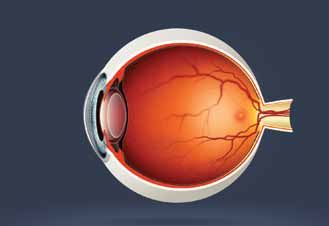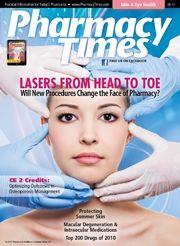Publication
Article
Pharmacy Times
Macular Degeneration and Intraocular Medications
Author(s):
Pharmacists cannot stop the progressive loss in central vision that comes with age-related macular degeneration, but they can help patients understand the treatment options.
Pharmacists cannot stop the progressive loss in central vision that comes with age-related macular degeneration, but they can help patients understand the treatment options.

Age-related macular degeneration (AMD) is a chronic disease leading to progressive central vision loss.1,2 The symptom of central vision loss is due to the fact that the damaged macula is in the center of the retina (Figure).3,4 Patients with AMD may be unable to recognize faces, read, or drive a vehicle. In fact, AMD is the leading cause of irreversible blindness in the United States and the developed world.1 Patients typically affected are Caucasians older than 50 years. More than 15 million Americans have AMD, and this number is expected to increase over 50% by the year 2020.5
Symptoms of AMD include decreased central vision, central scotoma, and metamorphopsia. Scotoma is an area of partially diminished vision surrounded by a field of normal or well-preserved vision. Metamorphopsia is a visual defect that causes people to see objects in a distorted manner; straight objects appear wavy or curvy. Patients will complain of distorted vision, lack of bright colors, or blurred vision. The presence of drusen, or yellow deposits deep within the retina, is commonly seen in AMD early in the course of the disease.2,5
AMD is diagnosed during a complete eye examination, including visual and fluorescein angiography. 5 There are 2 types of macular degeneration: dry and wet. Dry macular degeneration, also known as the nonexudative form, is more common and found in approximately 90% of AMD patients. The onset of dry AMD is subacute. Management of dry AMD includes attempts to prevent progression to and frequent monitoring for the development of wet macular degeneration.1 Wet (also known as exudative or neovascular) macular degeneration occurs in about 10% of AMD patients. It is the more acute form and more likely to cause vision loss.
The use of Amsler’s Chart by patients can often help detect vision changes early. The chart consists of a grid with straight and even lines. If the patient sees a dark spot in the center of the grid or if the lines appear wavy, he or she should see an ophthalmologist.6
Risk Factors
The causes of AMD are unknown, but well-defined risk factors have been identified. Some include:
• Advancing age (older than 50 years; onset is most common between 75 and 80 years)
• Caucasian descent
• History of smoking
• Poor diet—low intake of antioxidants, zinc, and lutein; high fat intake
• Genetic factors
• Hypertension
There may be evidence that AMD could result from cardiovascular disease but the link has not been proven. Other hypothesized etiologies include cumulative light damage, inflammatory processes, and hemodynamic abnormalities.7 Recently, the results of the Carotenoids in Age-Related Eye Disease Study (AREDS) concluded that individuals with a combination of 3 healthy behaviors (not smoking, healthy diet, physical exercise) had a 71% lower risk of developing AMD.8
Therapy
Some medical professionals recommend the use of “eye vitamins” with antioxidants to prevent further damage due to AMD. Several studies looked at the potential benefits of antioxidant supplementation. AREDS, for example, examined trial participants who received high doses of zinc, vitamins C and E, and beta-carotene. These patients had a 25% reduced risk of progression from early cases of AMD to late stage disease.7 In the Rotterdam Eye Study, patients were administered high doses of zinc, beta-carotene, and vitamins C and E. The treated patients showed a significant reduction in AMD of 35%.7 However, some investigators suggest caution. There is evidence that large amounts of beta-carotene in smokers will cause an increase in the incidence of lung cancer.
Photodynamic therapy (PDT) with vertepofin has been used since 2000 for wet/neovascular macular degeneration. Vertepofin, a photosensitizer, is administered intravenously. Low-intensity light activates the vertepofin, which selectively destroys the choroidal neovascular membrane. The choroid, which is behind the retina, provides the blood supply to the macula.2 PDT is only moderately effective in reducing further vision loss, and does not improve visual acuity.1
Today, the most common therapy for wet AMD is a vascular endothelial growth factor (VEGF) antagonist drug. VEGF is an angiogenic factor found to be a potent inducer of choroidal neovascularization, which may contribute to wet macular degeneration. Currently, 2 anti-VEGF drugs are approved for use in the United States for neovascular macular degeneration, although a third drug in the class is being studied and used by some ophthalmologists. These are administered intravitreally (intraocularly) every 4 to 6 weeks. Pretreatment with an antiseptic and a topical anesthetic is performed before administration.9
Pegaptanib sodium (Macugen; Eyetech/ Pfizer) was the first in the anti-VEGF category to be approved for AMD. Pegaptanib causes antiangiogenic and antipermeability effects by selectively binding to and inhibiting the actions of VEGF165. Vision stabilization occurs in about 70% of study patients, but vision improvement is seen in less than 10% of patients.1 The dose for pegaptanib is 0.3 mg intravitreally every 6 weeks for up to 2 years. The most common adverse effects are anterior chamber inflammation, eye pain, increased intraocular pressures and vitreous floaters.3,4
Ranibizumab (Lucentis; Genentech) is an antigen-binding fragment of an anti-VEGF antibody. Several large prospective randomized controlled trials investigating ranibizumab have been performed. Both the Minimally Classic/ Occult Trial of the Anti-VEGF Antibody Ranibizumab in the Treatment of Neovascular AMD (MARINA) and the Anti-VEGF Antibody for the Treatment of Predominately Classic Choroidal Neovascularization in AMD (ANCHOR) trials showed positive results.10,11 These trials showed a 95% and 96% rate, respectively, of reduced disease progression or stable or improved vision after 1 year. Importantly, between 34% and 40% of the patients in the ranibizumab studies demonstrated improved visual acuity.10,11 The dose for ranibizumab is 0.5 mg/0.05 mL intravitreally every 28 days. Most patients are able to tolerate ranibizumab. The most common adverse reactions are conjunctival hemorrhage, eye pain, vitreous floaters, increased intraocular pressure, and intraocular inflammation.12
Bevacizumab (Avastin; Genentech) is a recombinant humanized monoclonal anti-VEGF antibody, approved for use by the FDA for metastatic colorectal cancer, but not for AMD. Bevacizumab binds and blocks all forms of VEGF-A. There is currently a debate regarding the use of bevacizumab for AMD. Some ophthalmologists are administering bevacizumab to their AMD patients off-label. The manufacturer has not initiated studies of bevacizumab in the treatment of AMD, citing that the drug offers no benefit over ranibizumab. Eye care professionals have been vocal in requesting the availability of bevacizumab to treat their patients who are unable to pay for ranibizumab. Each dose of ranibizumab costs about $2000, whereas each dose of bevacizumab is less than $150. Bevacizumab is available to ophthalmologists who may then request compounding pharmacies to prepare the drug for intravitreal injection.13
In the recent ABC Trial, bevacizumab was administered to 131 patients with wet AMD. In this study, 32% of the patients treated with bevacizumab gained visual acuity, compared with 2% in the control group.9 A new study, Comparisons of Age-Related Macular Treatments Trials (CATT) is funded by the National Institute of Health and will compare the effectiveness of bevacizumab and ranibizumab. Published results are expected in 2011.
Conclusion
It is important to remind patients at risk for AMD to have regular eye exams, even when they are symptom-free. Patients complaining of a recent or chronic loss or change of vision should be urged to see an ophthalmologist immediately. A healthy lifestyle may help prevent AMD. This includes not smoking, eating a healthy diet, and being physically active. Following the recommended guidelines and the use of appropriate pharmacologic agents may help patients with AMD slow vision loss progression, increase visual acuity, and experience a greater quality of life. PT
Dr. von Koeckritz is a medical writer who resides in Westminster, Maryland, and practices pharmacy at Carroll Hospital Center.
References
1. Gohel PS, Mandava N, Olson JL, Durairaj VD. Age-related macular degeneration: an update on treatment. Am J Med. 2008;121(4):279-281.
2. Horton J. Disorders of the eye. In: Fauci AS, Braunwald E, Kasper DL, et al, eds. Harrisons' Principles of Internal Medicine. 17th ed. New York, NY: McGraw-Hill; 2008:180-195.
3. Macugen [prescribing information]. www.macugen.com/presinfo.asp. New York, NY: Eyetech Inc; 2011. Accessed April 13, 2011.
4. Macugen [package insert]. www.macugen.com/macugenUSPI.pdf. New York, NY: Eyetech Inc; 2011.
5. Ferri FF. Macular degeneration. In: Ferri: Ferri's Clinical Advisor 2011. Philadelphia, PA: Elsevier; 2010:1-8.
6. Foundation AMD. What is macular degeneration? www.macular.org/sitemap.html. Published 2010. Accessed April 13, 2011.
7. Connell PP, Keane PA, O’Neill EC, et al. Risk factors for age-related maculopathy. J Ophthalmol. 2009;2009:360764.
8. Mares JA, Voland RP, Sondel SA, et al. Healthy lifestyles related to subsequent prevalence of age-related macular degeneration. Arch Ophthalmology. 2011;129(4):470-480.
9. Tufail A, Patel PJ, Egan C, et al. Bevacizumab for neovascular age related macular degeneration (ABC Trial): multicentre randomised double masked study. BMJ. 2010;340(jun09 4):c2459-c2459.
10. Rosenfeld PJ, Brown DM, Heier JS, et al. Ranibizumab for neovascular age-related macular degeneration. New EnglandJournal of Medicine. 2006;355(14):1419-1431.
11. Brown DM, Kaiser PK, Michels M, et al. Ranibizumab versus Verteporfin for neovascular age-related macular degeneration. New EnglandJournal of Medicine. 2006;355(14):1432-1444.
12. Lucentis [package insert]. San Francisco, CA: Genetech; 2010. www.lucentis.com/lucentis/pdf/prescribing_information.pdf.
13. Haddrill M. Lucentis vs. Avastin: a macular degeneration treatment controversy. All About Vision. www.allaboutvision.com/conditions/lucentis-vs-avastin.htm. Published 2010. Accessed April 13, 2011.







